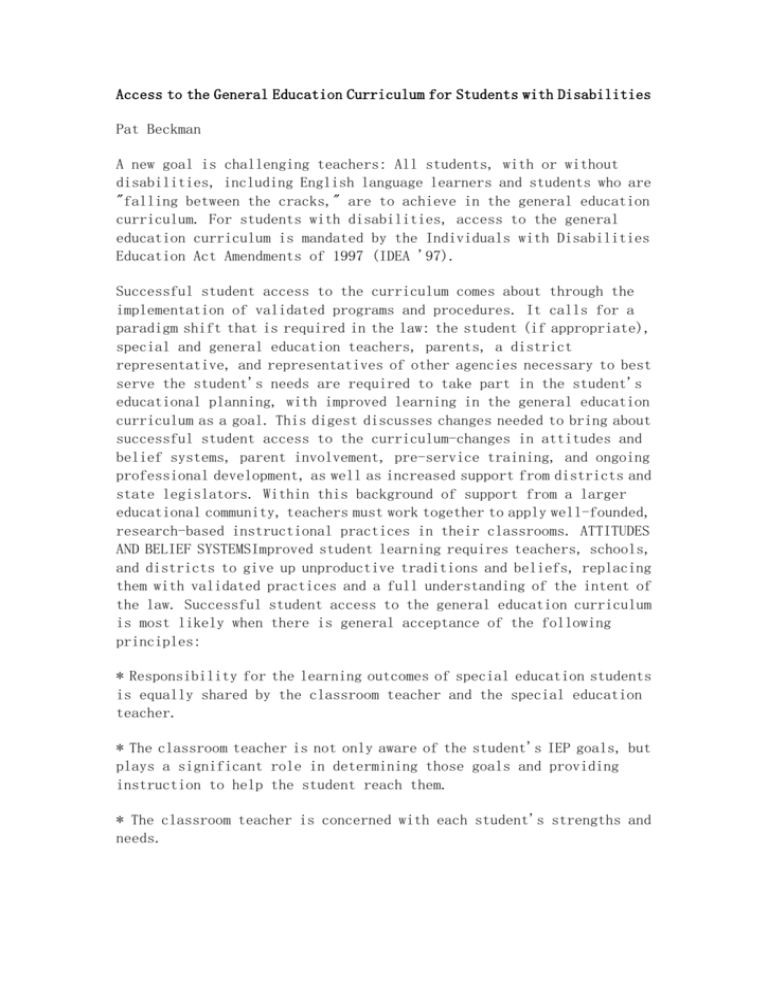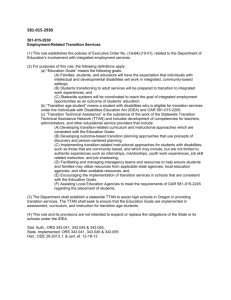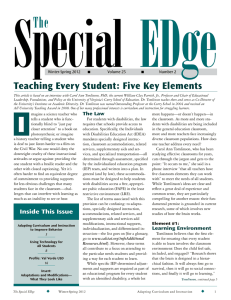Access to the General Education Curriculum for Students with
advertisement

Access to the General Education Curriculum for Students with Disabilities Pat Beckman A new goal is challenging teachers: All students, with or without disabilities, including English language learners and students who are "falling between the cracks," are to achieve in the general education curriculum. For students with disabilities, access to the general education curriculum is mandated by the Individuals with Disabilities Education Act Amendments of 1997 (IDEA '97). Successful student access to the curriculum comes about through the implementation of validated programs and procedures. It calls for a paradigm shift that is required in the law: the student (if appropriate), special and general education teachers, parents, a district representative, and representatives of other agencies necessary to best serve the student's needs are required to take part in the student's educational planning, with improved learning in the general education curriculum as a goal. This digest discusses changes needed to bring about successful student access to the curriculum-changes in attitudes and belief systems, parent involvement, pre-service training, and ongoing professional development, as well as increased support from districts and state legislators. Within this background of support from a larger educational community, teachers must work together to apply well-founded, research-based instructional practices in their classrooms. ATTITUDES AND BELIEF SYSTEMSImproved student learning requires teachers, schools, and districts to give up unproductive traditions and beliefs, replacing them with validated practices and a full understanding of the intent of the law. Successful student access to the general education curriculum is most likely when there is general acceptance of the following principles: * Responsibility for the learning outcomes of special education students is equally shared by the classroom teacher and the special education teacher. * The classroom teacher is not only aware of the student's IEP goals, but plays a significant role in determining those goals and providing instruction to help the student reach them. * The classroom teacher is concerned with each student's strengths and needs. * Administrators understand that teachers need time within their contracts to prepare standards-based activities and materials designed to meet the diverse needs of their students. * Collaboration is valued: Time is allocated for teachers to collaborate with other teachers and parents regarding students. Ideally, paid days at the end of each school year are provided so that teachers can discuss their students, improving the students' chances for smooth transitions to the next grade. * Expectations are not set according to a student's classification; it is recognized that a classification does not determine how much or how well the student will learn or perform. * It is understood that good instruction incorporates variation in delivery, activities, expectations, and assessment to accommodate diverse learning strengths and needs. * Accountability is considered a challenge, not a threat. As required by IDEA '97, students with disabilities are included in state and district assessments. * Parents are considered to be part of the team. PARENT INVOLVEMENTIDEA '97 mandates that parents be participants in the educational planning for their children. These mandates support the idea that an inclusive school creates a society of learners that involves parents and the school's community in meaningful contributions to the education of its students. The following activities lead to productive collaboration between the parent and the school: * Obtain information from parents about their child at the beginning of the year. * Contact parents often, informing them of successes as well as problems. * Contact parents at early onset of a learning or behavior problem, and ask them for feedback and ideas on how the problem could best be handled. * As mandated in IDEA, invite the parents to any formal meetings concerning the child. TRAINING AND PROFESSIONAL DEVELOPMENTIDEA '97 made federal funds available for in- and pre-service training to states that qualify for a State Improvement Grant (SIG). These grants are awarded to states that have developed a plan to improve educational outcomes for students with disabilities. Ensuring that all students gain access to the general education curriculum not only requires teacher commitment, but necessitates that districts support individual schools' efforts to improve teacher skills. Each school has its own set of unique circumstances. When staff identify and address their own training needs, they become better able to tackle the challenges they face in the classroom. In accordance with the principles of inclusion, a growing number of schools are assuming greater control over professional development activities, often moving from traditional training models to more participatory or job-embedded forms of learning. GAINING DISTRICT AND INFORMED LEGISLATIVE SUPPORTState legislators need relevant and accurate information for making appropriate decisions regarding education statutes and funding. For example, implementing change usually requires additional teacher time and resources. In some states, legislatures and districts are allocating monies to provide for additional teacher-paid training days. States are also considering the idea of offering teachers varied contract options. For example, teachers interested in developing instructional plans and activities would be on an 11-month contract, using non-teaching days to accomplish this. Their products would address the state curriculum standards as well as the diverse instructional and assessment needs of students. Through these efforts, data banks of curricular plans, activities, suggested materials, and additional resources can be made available on-line as well as in print. COMING TOGETHERSchools with successful inclusion programs have faculties that work together. It is recognized that all teachers are specialists who bring their areas of expertise to the table when planning and making decisions about students. Classroom teachers are specialists in curriculum; special education teachers, including related service personnel, are specialists in the unique learning and behavior needs of students. Each specialist learns skills from the others with all students being the ultimate beneficiaries. Effectively bringing all of this expertise to the classroom requires adhering to organizational principles designed to help all students learn, and yet allowing for their individual variations. Classroom instruction should be tied to state and district curriculum standards and objectives, which should at some level be appropriate for all students. The following teaching strategies help students learn the curriculum and develop independent learning skills: * Making accommodations and modifications for individuals when needed * Using multiple instructional delivery systems (e.g., visuals, audio, multi-sensory) * Using grouping variations such as cooperative learning groups * Helping students understand their own learning profiles * Teaching them to use cognitive and metacognitive strategies. Inclusive teaching also relies on ongoing informal classroom assessments so that teachers can begin teaching at the student's present performance level, keep abreast of student progress, and make appropriate instructional decisions. Assessments are matched to student learning styles. As classrooms are becoming more diverse, new instructional strategies and technologies are being developed to help teachers accommodate diversity. For example, principles of differentiation (Tomlinson, 1999) are being implemented and universal design (Orkwis & McLane, 1998) is being applied to facilitate access to the curriculum by students of diverse abilities and needs. New directions such as these help all students move toward progress in the general curriculum. RESOURCESAlder, L. (2000). How can special education students access the Utah Core Curriculum? Utah Special Educator 21(2), 10-11. Beckman, P. (2000). Utah's school-to-school project: AIMing for student success. Utah Special Educator 21(2), 19-20. Costa, A. L. & Kallick, B. (2000). Habits of mind. Alexandria, VA: Association for Supervision and Curriculum and Development. Orkwis, R., & McLane, K. (1998). A curriculum every student can use: Design principles for student access. ERIC/OSEP Topical Brief. Reston, VA: ERIC/OSEP Special Project. [on-line at http://www.cec.sped.org/osep/udesign.html] Pressley, P., & Woloshyn, V. (1995). Cognitive strategy instruction. Cambridge, MA: Brookline Books. Tomlinson, C. A. (1999). The differentiated classroom: Responding to the needs of all learners. Alexandria, VA. Association for Supervision and Curriculum Development. Ysseldyke, J. (2001). Reflections on a research career: Generalizations from 25 years of research on assessment and instructional decision making. Exceptional Children 67(3), 295-308.









